Integration of Technological Resources and Problem-Solving Method for the Development of Research Competencies in Engineering and Nursing Students from Two Public Universities in Peru
Abstract
1. Introduction
2. Literature Review
2.1. Formative Research
2.2. Pólya’s Problem-Solving Method Through the Use of Technological Resources
2.3. Technological Resources in Education
2.4. Development of Research Activities Based on Pólya’s Method and the Use of Technological Resources
- Understanding the problem: In this phase, essential research competencies are strengthened in students, as it involves the ability to identify, analyze, and contextualize real-world problems from their surroundings. This process fosters the search for, critical evaluation, and synthesis of relevant scientific and technical information, which constitute a fundamental first step in research training (Espinoza, 2020; Hernández et al., 2020). Moreover, it enhances the development of critical thinking and the formulation of researchable questions—key skills for quality university education and the training of future professionals committed to solving social and health-related issues (Rivas et al., 2020; Turpo-Gebera et al., 2020). This phase ensures that the student is not a passive receiver of knowledge but an active agent capable of interpreting reality and proposing lines of inquiry.
- Designing activities: This phase focuses on the detailed planning of research actions, the search and analysis of background information, and the logical and sequential structuring of tasks. This process strengthens the student’s ability to organize a formative research project methodologically, fostering autonomy and informed decision-making (Llanos de Tarazona, 2019). It also enables future professionals to design projects with a critical and creative focus aligned with the real needs of their environment, which is essential for training in health sciences and for promoting a sustainable research culture (Allison & Joo, 2014; Molina et al., 2020).
- Implementing activities: In this phase, students acquire practical knowledge about the use of technological resources (sensors, electronic kits, visual programming, among others) and apply these tools to solve the identified problem. This process fosters active experimentation, the development of technical skills, and the ability to work collaboratively—fundamental aspects of meaningful learning and the development of practical competencies (Fidai et al., 2020; Paucar-Curasma et al., 2023). It also encourages the creation of functional prototypes and solutions, such as models or interactive applications, which allow students to translate their ideas into tangible products. This strengthens the integration between theory and practice and promotes technological innovation in education (Paucar-Curasma et al., 2023b; Paucar-Curasma et al., 2024a, 2024b).
- Reviewing the solution: In this phase, students conduct a critical analysis of the results and validate the proposed solutions. This process enhances their ability to reflect on procedures and outcomes, identify areas for improvement, and propose optimizations to the designed solutions. In addition, the development of metacognition, understood as the ability to evaluate and improve one’s own research practices (Espinoza, 2020; Flores & Trujillo, 2024), is promoted. This reflective component is essential for consolidating solid research competencies and fostering academic autonomy, preparing students to face future professional challenges critically and adaptively.
3. Materials and Methods
3.1. Research Approach and Participants
3.2. Instrument and Data Analysis
3.3. Formative Research Projects in the Classroom
3.3.1. Formative Research Projects for Engineering Students
3.3.2. Formative Research Projects for Nursing Students
3.4. Development of Investigative Activities Following Pólya’s Method
- (a)
- Understanding the problem (5 sessions).
- (b)
- Designing activities (3 sessions).
- (c)
- Implementing activities (6 sessions).
- (d)
- Review of the solution (2 sessions).
4. Results
4.1. Descriptive Evaluation of Research Competence According to the Problem-Solving Phases
4.2. Normality Test of Collected Data
4.3. Hypothesis Testing of Research Competence According to the Problem-Solving Phases
4.4. Analysis of the Development of Research Competence According to the Phases of Problem-Solving and Academic Program
5. Discussion
6. Conclusions
Author Contributions
Funding
Institutional Review Board Statement
Informed Consent Statement
Data Availability Statement
Conflicts of Interest
References
- Alejandro, J., & Zamora, C. (2024). Application of interactive technological resources for the development of logical-mathematical thinking in the teaching of basic operations in basic education. Revista Científica Multidisciplinaria, 2(4), 102–117. [Google Scholar] [CrossRef]
- Allison, M., & Joo, S. (2014, August 22–24). Revisiting Polya’s approach to foster problem solving skill development in software engineers. The 9th International Conference on Computer Science & Education (ICCSE 2014), Vancouver, BC, Canada. [Google Scholar] [CrossRef]
- Alvarado, F., Villar-Mayuntupa, G., & Roman-Gonzalez, A. (2020, March 15–18). The formative research in the development of reading and writing skills and their impact on the development of indexed publications by engineering students. 2020 IEEE World Conference on Engineering Education (EDUNINE), Bogota, Colombia. [Google Scholar]
- Arbeu-Reyes, E., Torquemada-González, A., & Orozco-Ramírez, L. (2024). For the development of investigative skills through the use of digital tools: Mendeley and Obsidian. Revista Transdisciplinaria de Estudios Sociales y Tecnológicos, 4(2), 33. [Google Scholar] [CrossRef]
- Barrios Soto, L. M., & Delgado González, M. (2021). Efectos de los recursos tecnológicos en el aprendizaje de las matemáticas. Revista Digital: Matemática, Educación e Internet, 22(1), 5731. [Google Scholar] [CrossRef]
- Boakye, D. S., Kwashie, A. A., Adjorlolo, S., & Korsah, K. A. (2024). Nursing education for sustainable development: A concept analysis. Nursing Open, 11(10), 70058. [Google Scholar] [CrossRef]
- Cabrera-Berrezueta, B., Cárdenas-Cordero, N., & García-Herrera, D. G. (2020). La investigación formativa en Educación Superior: Modelo para docentes y estudiantes. Killkana Social, 4(2), 75–82. [Google Scholar] [CrossRef]
- Chacón-Castro, M., Buele, J., López-Rueda, A. D., & Jadán-Guerrero, J. (2023). Pólya’s methodology for strengthening problem-solving skills in differential equations: A case study in Colombia. Computers, 12(11), 12110239. [Google Scholar] [CrossRef]
- Diaz, B., Montes, M., & Cangahuala, O. (2017). La investigación formativa en el pregrado: Una propuesta desde el plan de estudios de la Facultad de Ciencias Contables de la PUCP. Revista Científica Hermes, 19, 409–431. [Google Scholar] [CrossRef]
- Dipas, B., Rodríguez, J., Rodríguez, C., & Rodríguez, J. (2022). Investigación formativa para desarrollar competencias investigativas de los estudiantes. Ciencia Latina Revista Científica Multidisciplinar, 6(6), 9687–9708. [Google Scholar] [CrossRef]
- Dúo-Terrón, P. (2023). Analysis of scratch software in scientific production for 20 years: Programming in education to develop computational thinking and STEAM disciplines. Education Sciences, 13, 4. [Google Scholar] [CrossRef]
- Espinoza, E. E. (2020). La investigación formativa. Una reflexión teórica. Revista Conrado, 16(74), 45–53. [Google Scholar]
- Fernández, F., & Duarte, J. (2013). El aprendizaje basado en problemas como estrategia para el desarrollo de competencias específicas en estudiantes de ingeniería. Formacion Universitaria, 6(5), 29–38. [Google Scholar] [CrossRef]
- Fidai, A., Capraro, M. M., & Capraro, R. M. (2020). “Scratch”-ing computational thinking with Arduino: A meta-analysis. Thinking Skills and Creativity, 38, 100726. [Google Scholar] [CrossRef]
- Flores, E., & Trujillo, A. V. (2024). Metacognición y autorregulación del aprendizaje. Revista Fedumar, 11(1), 194. [Google Scholar] [CrossRef]
- Fronza, I., Corral, L., & Pahl, C. (2019, October 3–5). Combining block-based programming and hardware prototyping to foster computational thinking. SIGITE 2019—Proceedings of the 20th Annual Conference on Information Technology Education (pp. 55–60), Tacoma, WA, USA. [Google Scholar] [CrossRef]
- Gardose, C. K. C., Castillo, A. A., & Madroñal, M. H. (2025). Comic-polya method integration in physics: Enhance students’ conceptual understanding and motivation. Indonesian Journal of Education Research (IJoER), 6(1), 35–44. [Google Scholar] [CrossRef]
- Hamid, J., Omar, S., Mohd, Z., & Mohamad, U. (2022). Improving college students’ learning performance in computer programming: The case of using the polya model. Central Asia and the Caucasus, 23(1), 3052–3070. [Google Scholar] [CrossRef]
- Hernández, A., Illesca-Pretty, M., Hein-Campana, K., & Godoy-Pozo, J. (2020). Percepción del estudiante de enfermería sobre investigación formativa Perception of nursing students about formative research. AMC, 6(24), 774–785. [Google Scholar]
- Jahudin, J., & Siew, N. M. (2024). The effects of polya’s problem solving with digital bar model on the algebraic thinking skills of seventh graders. Problems of Education in the 21st Century, 82(3), 390–409. [Google Scholar] [CrossRef]
- Jiménez, E., Servetto, A., & Calvo, P. (2020). Desarrollo de pensamiento computacional en estudiantes de ingeniería. En *Memorias de las 3° Jornadas sobre las Prácticas Docentes en la Universidad Pública: El proyecto político académico de la Educación Superior en el contexto nacional y regional* (pp. 598–608). Universidad Nacional de La Plata. Available online: https://sedici.unlp.edu.ar/handle/10915/105868 (accessed on 14 September 2025)ISBN 978-950-34-1965-6.
- Karmawan, P., & Djamilah, W. (2024). STEM: Its potential in developing students’ computational thinking. KnE Social Sciences, 1074–1083. [Google Scholar] [CrossRef]
- Klever, O. (2021). Método Pólya y simulaciones en el desarrollo de competencias para la resolución de problemas. Universidad del Norte. [Google Scholar]
- Lapa-Asto, U., Tirado-Mendoza, G., & Roman-Gonzalez, A. (2019, March 17–20). Impact of formative research on engineering students. 2019 IEEE World Conference on Engineering Education (EDUNINE), Lima, Peru. [Google Scholar]
- Llanos de Tarazona, M. (2019). Uso de tecnologías de información y comunicación y habilidades investigativas en estudiantes de enfermería. Revista Peruana de Ciencias de La Salud, 1(4), 185–190. [Google Scholar] [CrossRef]
- Llorens, F., García-Peñalvo, F. J., Molero, X., & Vendrell, E. (2017). La enseñanza de la informática, la programación y el pensamiento computacional en los estudios preuniversitarios [The teaching of computer science, programming and computational thinking in pre-university studies]. Education in The Knowledge Society, 18(2), 7–17. Available online: http://revistas.usal.es/index.php/eks/article/view/eks2017182717/17445%0Ahttp://rua.ua.es/dspace/handle/10045/68598 (accessed on 14 September 2025). [CrossRef][Green Version]
- Llulluy-Nuñez, D., Luis Neglia, F. V., Vilchez-Sandoval, J., Sotomayor-Beltrán, C., Andrade-Arenas, L., & Meneses-Claudio, B. (2021, July 19–23). The impact of the work of junior researchers and research professors on the improvement of the research competences of engineering students at a University in North Lima. Proceedings of the LACCEI International Multi-Conference for Engineering, Education and Technology, Bogota, Colombia. [Google Scholar] [CrossRef]
- Lozano-Ramírez, M. C. (2020). El aprendizaje basado en problemas en estudiantes universitarios. Tendencias Pedagógicas, 37, 90–103. [Google Scholar] [CrossRef]
- López, A., Ramos, G., & Gómez, C. (2018). La investigación formativa: Naturaleza y vínculos recíprocos con la investigación generativa en la educación superior. Uniandes EPISTEME. Revista Digital de Ciencia, Tecnología e Innovación, 5, 966–983. [Google Scholar]
- Lu, D., & Xie, Y.-N. (2024). The application of educational technology to develop problem-solving skills: A systematic review. Thinking Skills and Creativity, 51, 101454. [Google Scholar] [CrossRef]
- Magdaleno, J. A., & Malaga, S. G. (2024). Investigación formativa de estudiantes de enfermería: Un estudio mixto con diseño secuencial. IE Revista de Investigación Educativa de La REDIECH, 15, e2206. [Google Scholar] [CrossRef]
- Marín-Marín, J. A., García-Tudela, P. A., & Duo-Terrón, P. (2024). Computational thinking and programming with Arduino in education: A systematic review for secondary education. Heliyon, 10(8), e29177. [Google Scholar] [CrossRef] [PubMed]
- Melo, J., Fidelis, M., Alves, S., Freitas, U., & Dantas, R. (2020, November 9). A comprheensive review of Visual Programming Tools for Arduino. 2020 Latin American Robotics Symposium, 2020 Brazilian Symposium on Robotics and 2020 Workshop on Robotics in Education, LARS-SBR-WRE 2020, Natal, Brazil. [Google Scholar] [CrossRef]
- Molina, Á., Adamuz, N., & Bracho, R. (2020). La resolución de problemas basada en el método de Polya usando el pensamiento computacional y Scratch con estudiantes de Educación Secundaria. Handbook of Educational Psychology, 49, 287–303. [Google Scholar] [CrossRef]
- Müller, U., Hancock, D., Wang, C., Stricker, T., & Liu, Q. (2025). Implementing education for sustainable development in organizations of adult and continuing education: Perspectives of leaders in China, Germany, and the USA. Sustainability, 17(10), 4702. [Google Scholar] [CrossRef]
- Neo, C. H., Wong, J. K., Chai, V. C., Chua, Y. L., & Hoh, Y. H. (2021). Computational thinking in solving engineering problems—A conceptual model definition of computational thinking. Asian Journal of Assessment in Teaching and Learning, 11(1), 24–31. [Google Scholar] [CrossRef]
- Nguyen, L. C., Thuan, H. T., & Giang, T. T. H. (2023). A application of g. polya’s problem-solving process in teaching high-school physics. Journal La Sociale, 4(1), 26–33. [Google Scholar] [CrossRef]
- Olaniyan, A., & Govender, N. (2018). Effectiveness of polya problem-solving and target-task collaborative learning approaches in electricity amongst high school physics students. Journal of Baltic Science Education, 17(5), 765–777. [Google Scholar] [CrossRef]
- Olaniyan, A., Omosewo, E., & Nwankwo, L. (2015). Effect of polya problem-solving model on senior secondary school students’ performance in current electricity. European Journal of Science and Mathematics Education, 3(1), 97–104. [Google Scholar]
- Ortega, B., & Asensio, M. (2021). Evaluar el pensamiento computacional mediante resolución de problemas: Validación de un instrumento de evaluación. Revista Iberoamericana de Evaluación Educativa, 14(1), 153–171. [Google Scholar] [CrossRef]
- Öndeş, R. N. (2025). Effects of STEM practices on students’ problem-solving skills: A meta-analysis. International Journal of Education in Mathematics, Science and Technology, 13(2), 439–461. [Google Scholar] [CrossRef]
- Paucar-Curasma, R. (2023). Influencia del pensamiento computacional en los procesos de resolución de problemas en los estudiantes de ingeniería de reciente ingreso a la universidad. Available online: https://repositorio.uns.edu.pe/handle/20.500.14278/4199 (accessed on 22 June 2025).
- Paucar-Curasma, R., Barja-Huayta, C. R., Soriano-Quispe, Y., Pizarro-Avellaneda, J. C., Unsihuay-Tovar, R. F., Illesca-Cangalaya, O. F., & Quispe-Llamoca, R. (2025a). Promoting gender equality through computational thinking and STEM activities. Aibi Revista de Investigacion Administracion e Ingenierias, 13(1), 90–98. [Google Scholar] [CrossRef]
- Paucar-Curasma, R., Cerna-Ruiz, L. P., Acra-Despradel, C., Villalba-Condori, K. O., Massa-Palacios, L. A., Olivera-Chura, A., & Esteban-Robladillo, I. (2023). Development of computational thinking through stem activities for the promotion of gender equality. Sustainability, 15(16), 2335. [Google Scholar] [CrossRef]
- Paucar-Curasma, R., Frango, I., Rondon, D., López, Z., & Porras-Ccancce, L. (2022a). Analysis of the teaching of programming and evaluation of computational thinking in recently admitted students at a public university in the andean region of peru ronald. Congreso Internacional de Tecnología e Innovación Educativa, 3353, 101–110. [Google Scholar]
- Paucar-Curasma, R., Gamarra-Moreno, A., Rondon, D., Unsihuay, R., & Huayta-Meza, F. (2022b). Design of a hardware prototype with block programming to develop computational thinking in recently admitted engineering students. Congreso Internacional de Tecnología e Innovación Educativa, 3353, 111–117. [Google Scholar]
- Paucar-Curasma, R., Huayta-Meza, F. T., Jara, N. J., Illesca-Cangalaya, O. F., Porras-Ccancce, L. E., Romero-Gabino, A. J., López-Robles, Z. M., & Llamoca, R. Q. (2025b). Arduino and mBlock Projects to Enhance Computational Thinking in First-Year Engineering Students. Mathematical Modelling of Engineering Problems, 12(1), 241–252. [Google Scholar] [CrossRef]
- Paucar-Curasma, R., Tovar, R. F. U., Jiménez, S. C. A. V., Jara, N. J., Agama, S. H. G., & Quijada-Villegas, J. H. (2024a). Developing IoT activities using the problem-solving method: Proposal for novice engineering students. Mathematical Modelling of Engineering Problems, 11(11), 3161–3172. [Google Scholar] [CrossRef]
- Paucar-Curasma, R., Villalba-Condori, K. O., Gonzales-Agama, S. H., Huayta-Meza, F. T., Rondon, D., & Sapallanay-Gomez, N. N. (2024b). Technological resources and problem-solving methods to foster a positive attitude toward formative research in engineering students. Education Sciences, 14(12), 1397. [Google Scholar] [CrossRef]
- Paucar-Curasma, R., Villalba-Condori, K. O., Mamani-Calcina, J., Rondon, D., Berrios-Espezúa, M. G., & Acra-Despradel, C. (2023b). Use of technological resources for the development of computational thinking following the steps of solving problems in engineering students recently entering college. Education Sciences, 13(3), 279. [Google Scholar] [CrossRef]
- Pinto, A., & Cortés, O. (2017). ¿ Qué piensan los estudiantes universitarios frente a la formación investigativa? REDU. Revista de Docencia Universitaria, 15(2), 57–75. [Google Scholar] [CrossRef]
- Pluhár, Z., & Torma, H. (2019). Introduction to Computational Thinking for University Students. In S. Pozdniakov, & V. Dagienė (Eds.), Informatics in Schools. New Ideas in School Informatics. ISSEP 2019 (vol. 11913). Lecture Notes in Computer Science. Springer. [Google Scholar] [CrossRef]
- Pólya, G. (1945). How to solve it (2nd ed.). Princeton University Press, Doubleday Anchor Books. [Google Scholar]
- PROCIENCIA-CONCYTEC. (2024). Investigadores de huancavelica desarrollan dispositivo educativo para facilitar aprendizaje sencillo para universitarios–noticias–programa nacional de investigación científica y estudios avanzados–plataforma del estado peruano. Available online: https://www.gob.pe/institucion/prociencia/noticias/919234 (accessed on 11 June 2025).
- Restrepo Gómez, B. (2017). Conceptos y aplicaciones de la investigación formativa, y criterios para evaluar la investigación científica en sentido estricto. Available online: https://www.epn.edu.ec/wp-content/uploads/2017/03/Investigaci%C3%B3n-Formativa-Colombia.pdf (accessed on 21 May 2025).
- Rivas, L., Loli, R., & Quiroz, M. (2020). Percepción de estudiantes de enfermería sobre la investigación formativa en pregrado. ECIMED, 3(36), 1–15. [Google Scholar]
- Rossi-Rivero, R., & Padilla-Choperena, C. (2019). Tecnología, globalización e investigación en enfermería: Aproximaciones para un nuevo modelo de formación profesional. Revista Cultura Del Cuidado Enfermería, 16(1), 89–98. [Google Scholar]
- Salguero, J., Rodríguez, J., Salguero, R., & Rosas, P. (2025). Conceptual appropriation and perceived skills in formative research among university students. Education Sciences, 15(8), 944. [Google Scholar] [CrossRef]
- Sarmiento, M. I. (2020). Lenguajes y entornos de programación para fortalecer el desarrollo de competencias concernientes al pensamiento computacional. Hamut’Ay, 7(3), 86. [Google Scholar] [CrossRef]
- Sánchez Carlessi, H. H. (2017). La investigación formativa en la actividad curricular. Revista de La Facultad de Medicina Humana, 17(2), 836. [Google Scholar] [CrossRef]
- Suazo, J. (2014). Desarrollo de un módulo electrónico para la enseñanza del área de ciencia, tecnologia y ambiente en la educación secundaria peruana. PUCP, 98, 6213. [Google Scholar]
- Suárez, R., Cabrera, J., & Zapata, I. (2022). Specialized nursing professional. Does this specialist make the best use of technology in care? Revista Habanera de Ciencias Médicas, 3(21), 1–5. Available online: http://www.revhabanera.sld.cu/index.php/rhab/article/view/4056 (accessed on 22 March 2025).
- Trilles, S., Monfort-Muriach, A., Gomez-Cambronero, A., & Granell, C. (2022). Sucre4Stem: Collaborative projects based on IoT devices for students in secondary and pre-university education. Revista Iberoamericana de Tecnologias Del Aprendizaje, 17(2), 150–159. [Google Scholar] [CrossRef]
- Turpo-Gebera, O., Quispe, P. M., Paz, L. C., & Gonzales-Miñán, M. (2020). Formative research at the university: Meanings conferred by faculty at an education department. Educacao e Pesquisa, 46, 1–18. [Google Scholar] [CrossRef]
- UNESCO. (2020). Education for sustainable development: A roadmap. UNESCO. [Google Scholar] [CrossRef]
- Urquizo, G., Vidal, E., & Castro, E. (2021). Incorporación de pensamiento computacional en ingenierías como soporte a la competencia de desarrollo de problemas: Jugando con lightbot. Revista Ibérica de Sistemas e Tecnologias de Informação, E42, 199–208. [Google Scholar]
- Wu, J., Wang, Y., Kong, H., & Zhu, L. (2019, June 15–19). How to cultivate computational thinking-enabled engineers: A case study on the robotics class of zhejiang university. 2019 ASEE Annual Conference & Exposition, Tampa, FL, USA. [Google Scholar]
- Yasar, O. (2018, March 5–9). Computational thinking, redefined. Proceedings of Society for Information Technology & Teacher Education International Conference, Austin, TX, USA. Available online: https://www.learntechlib.org/primary/p/182505/ (accessed on 14 September 2025).
- Zhang, J., & Liu, J. (2018, October 22–24). Construction of scaffolding instruction mode for mblock for arduino maker course based on design thinking. ACM International Conference Proceeding Series (pp. 1–6), Hohhot, China. [Google Scholar] [CrossRef]
- Zúñiga-Cueva, J., Vidal-Duarte, E., & Padrón Alvarez, A. (2021, April 5–8). Methodological strategy for the development of research skills in engineering students: A proposal and its results. International Conference on Industrial Engineering and Operations Management (pp. 2525–2536), San Paulo, Brazil. [Google Scholar]

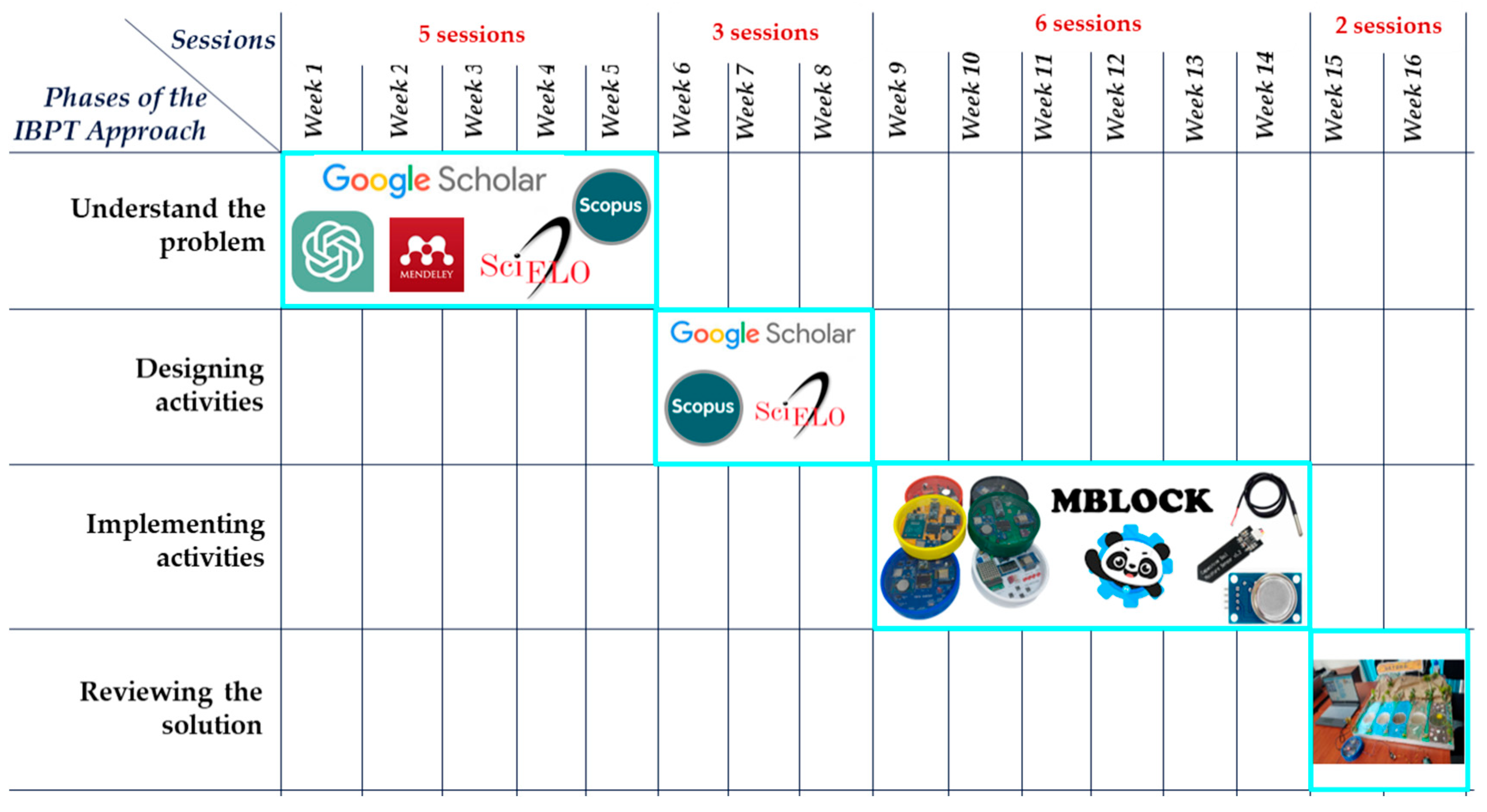

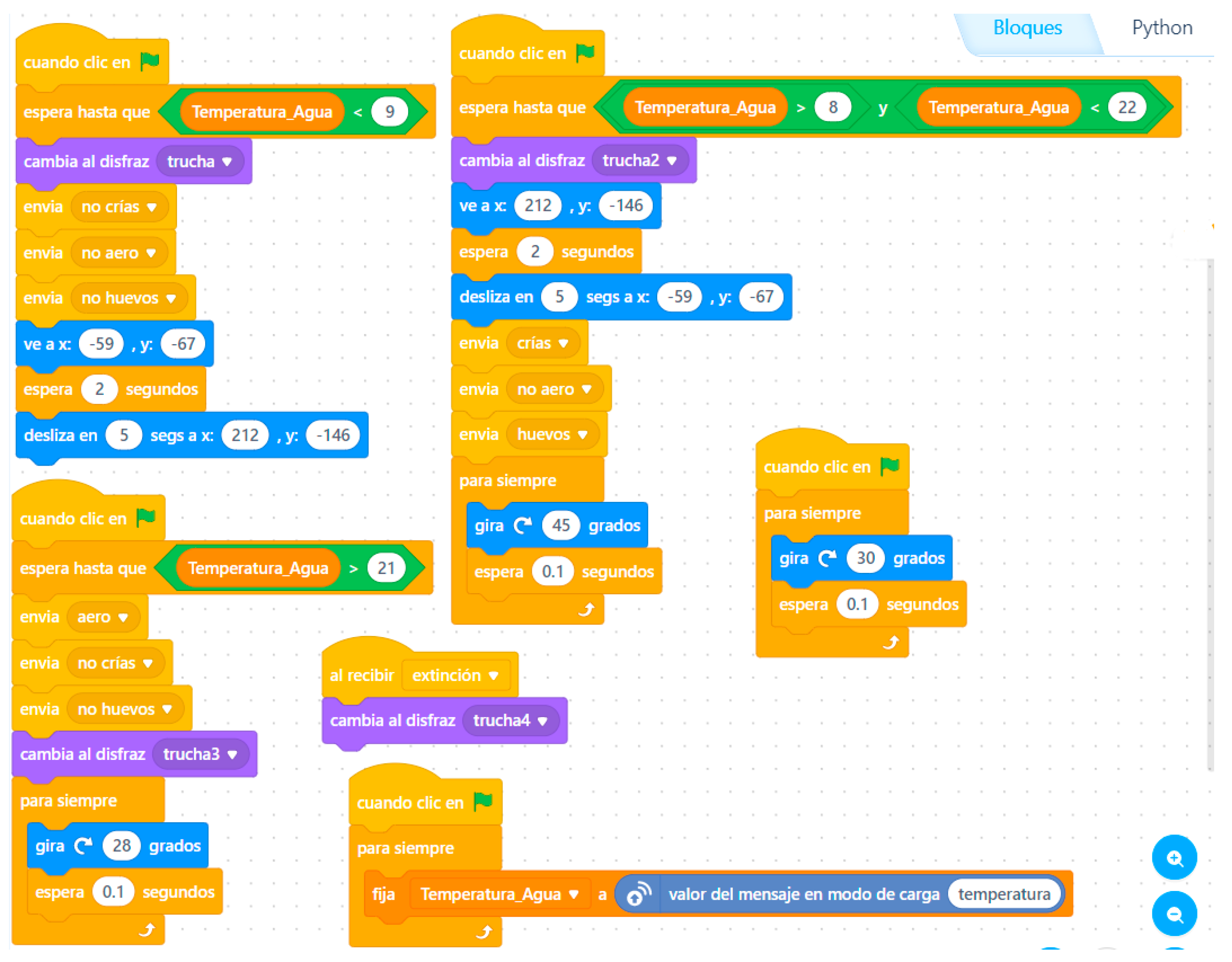
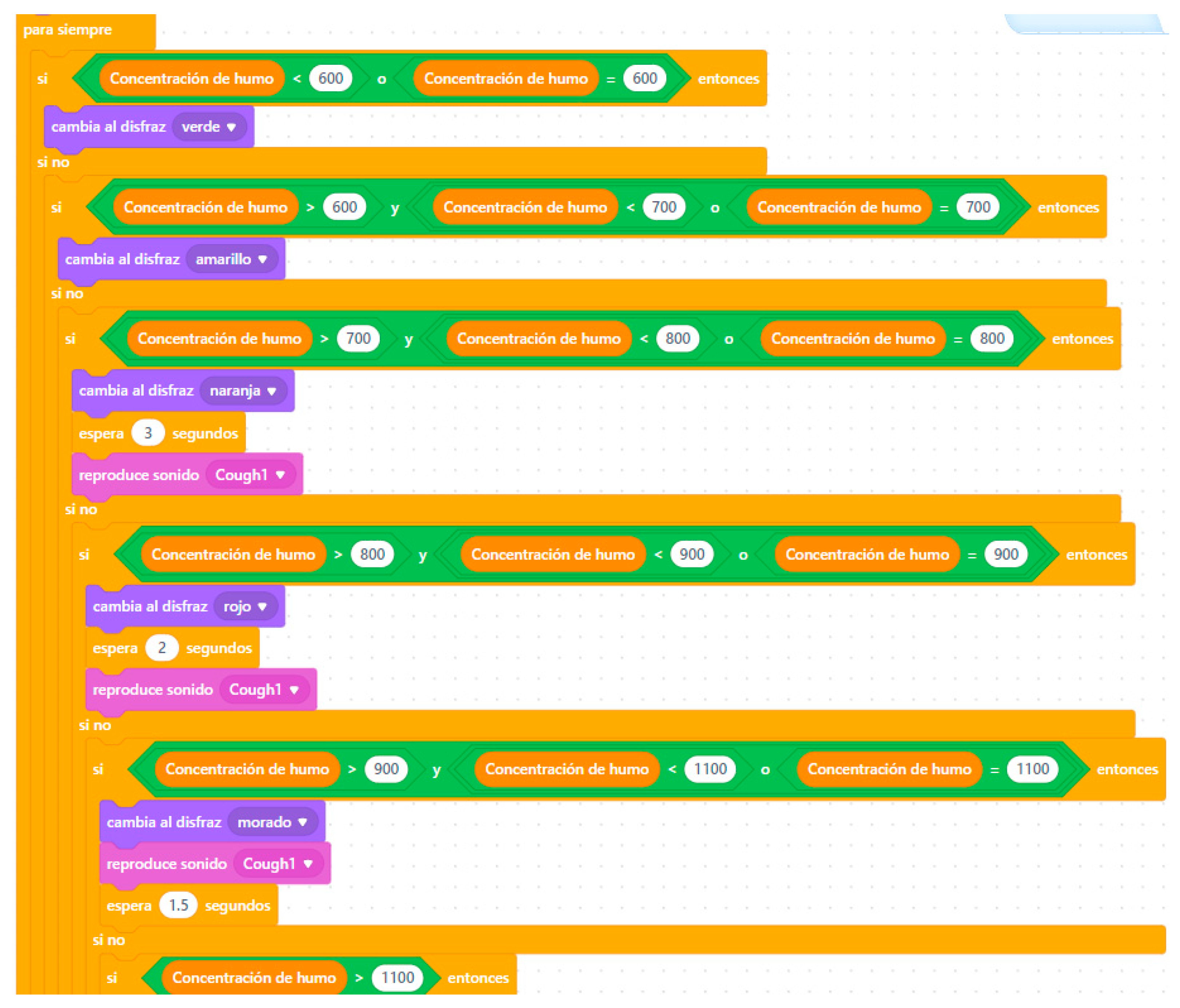
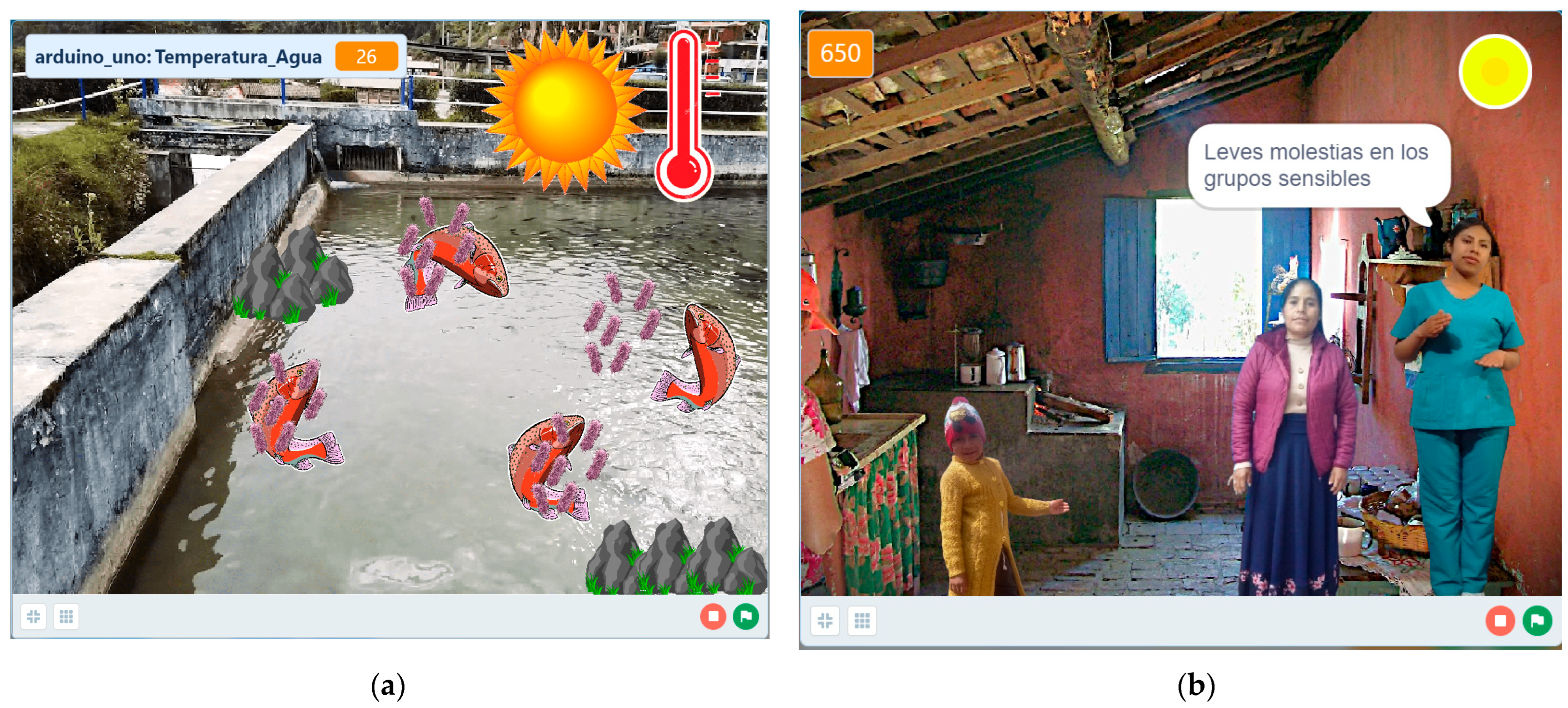

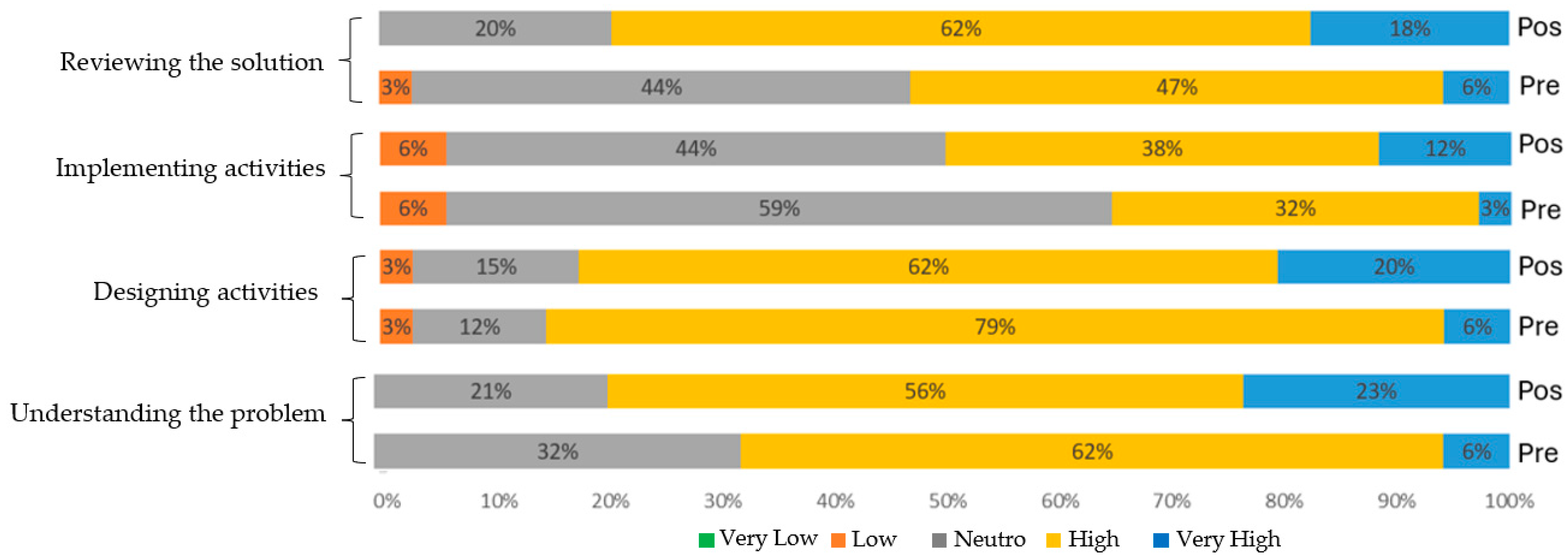
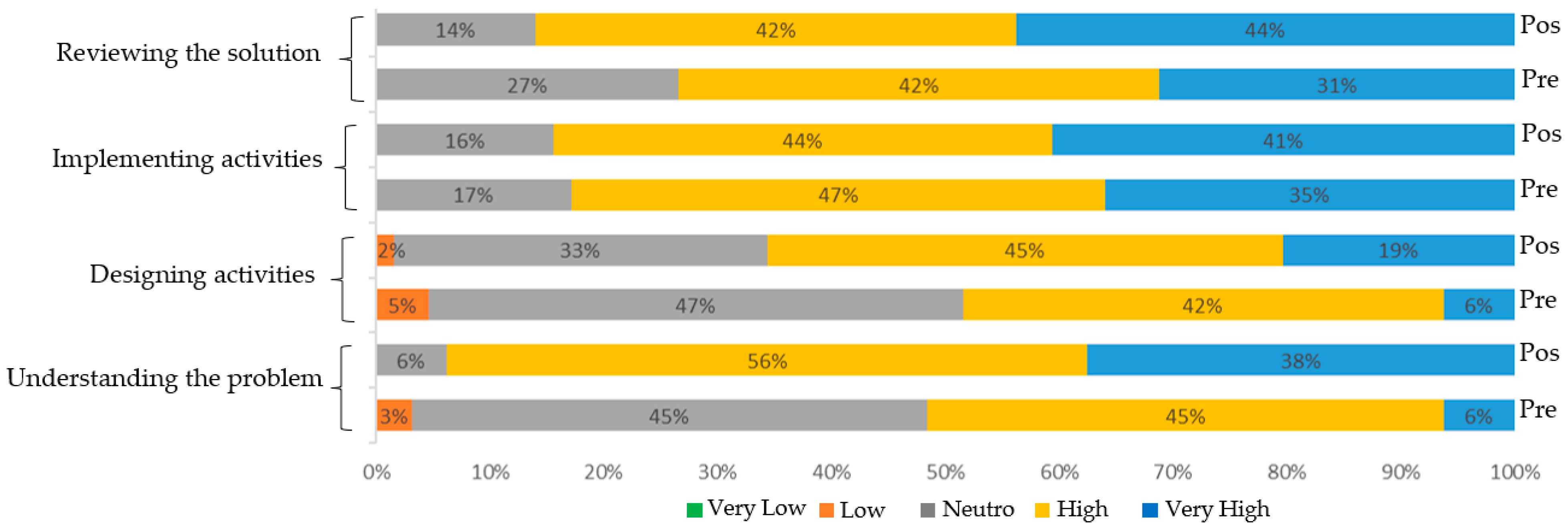
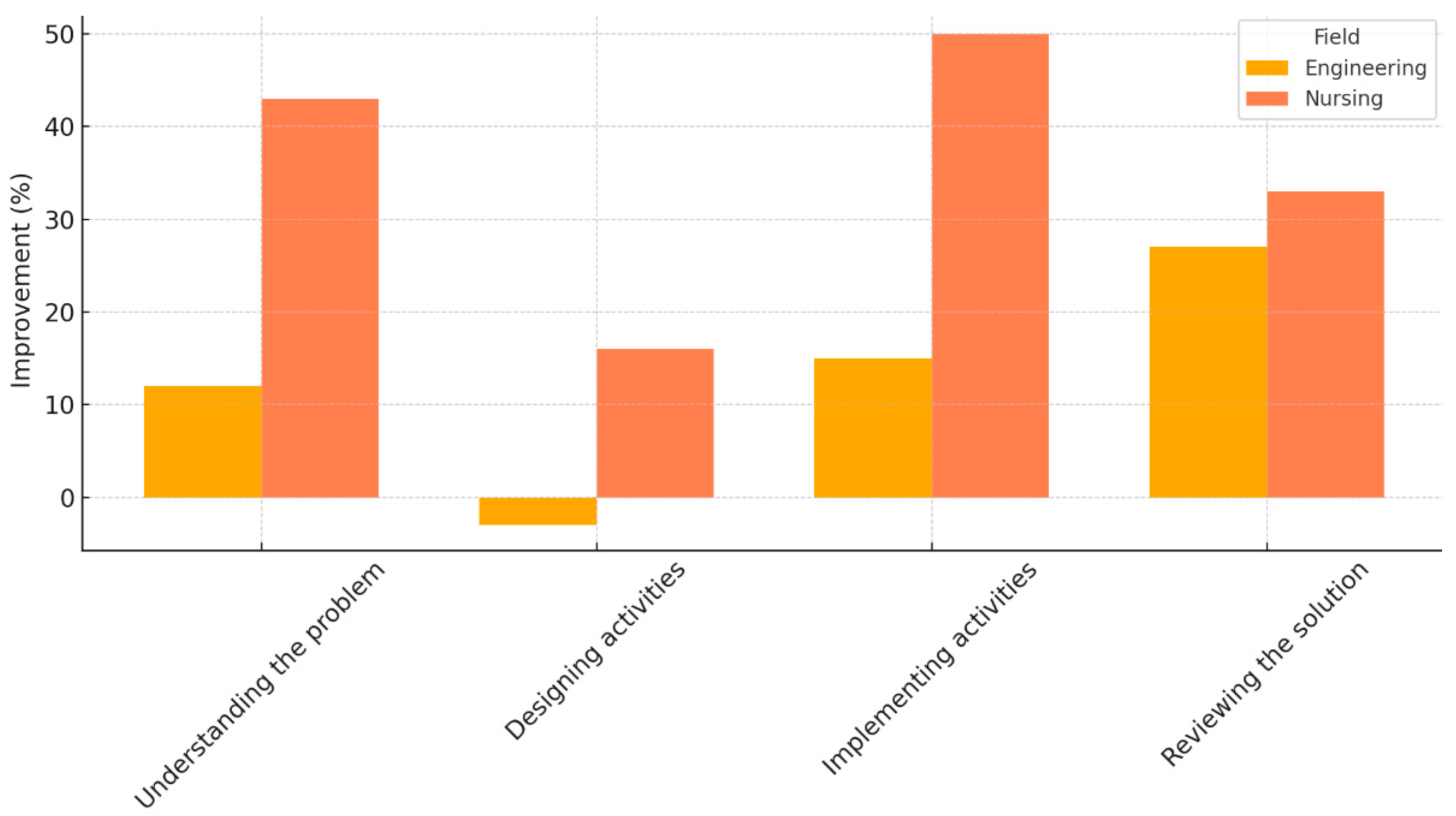
| University | Program | Male | Female | Total |
|---|---|---|---|---|
| Universidad Nacional del Centro del Perú | Systems Engineering | 28 | 6 | 34 |
| Universidad Nacional Autónoma de Tayacaja Daniel Hernández Morillo | Nursing | 11 | 53 | 64 |
| Formative Research Project | Description | Sensor | Electronic Device |
|---|---|---|---|
| Monitoring of Humidity and Temperature in the Computer Center of the Systems Engineering Faculty | Students used the DHT11 sensor to measure humidity and temperature in the computer center of the university to ensure proper conditions for experiments and research. |  DHT11 Sensor |  Arduino Board |
| Air Quality Monitoring in the Market Area of Huancayo City | Students monitored air quality in the market area of Huancayo city using the MQ135 gas sensor to protect public health. |  MQ135 Gas Sensor |  Arduino Board |
| Soil Moisture Control to Optimize Corn Cultivation in Cochas District | Students monitored soil moisture in corn fields using the capacitive soil moisture sensor to help farmers make appropriate decisions regarding corn production. |  Capacitive Soil Moisture Sensor |  Arduino Board |
| Security Monitoring for Access Control in a Company Library | Students monitored security access to the library, allowing entry only to authorized individuals. |  RFID Module RC522 |  Arduino Board |
| Water Temperature Monitoring in the Fish Farm Center of Ingenio, Junín | Students implemented a system to monitor water temperature in the fish farm to prevent stress in trout, using the DS18B20 sensor to maintain optimal conditions. |  DS18B20 Temperature Sensor |  Arduino Board |
| Monitoring Water Levels of Lake Paca in Jauja Province | Students developed a system to monitor the water level of Lake Paca using an ultrasonic sensor. |  HC-SR04 Ultrasonic Sensor |  Arduino Board |
| Formative Research Project | Description | Sensor | STEM Educational Kit |
|---|---|---|---|
| Monitoring Soil Moisture in Vegetable Crops to Prevent Anemia in School-Aged Children in Acraquia District, Tayacaja | The project involved monitoring soil moisture in vegetable crops to help prevent anemia in children, using the agriculture card, capacitive moisture sensor, and mBlock environment. |  Capacitive Moisture Sensor |  Agriculture Card |
| Air Quality Monitoring in Wood-Fired Households to Prevent Respiratory Problems in Andaymarca, Tayacaja | The project monitored air quality in wood-fired households using the environment card, air quality sensor, and mBlock programming to prevent respiratory issues. |  MQ135 Air Quality Sensor |  Environment Card |
| Monitoring Guinea Pig Breeding to Prevent Salmonella in Santa Rosa Community, Tayacaja | The project focused on monitoring guinea pig breeding to prevent contamination and human salmonella infection, using the livestock card, distance sensor, and mBlock programming. |  HC-SR04 Distance Sensor | 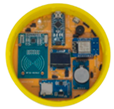 Livestock Card |
| Water Quality Monitoring to Prevent Stomach Infections in Ustuna District, Tayacaja | This project monitored water quality to prevent gastrointestinal infections, using the aquaculture card, turbidity sensor, and mBlock environment. |  Water Turbidity Sensor | 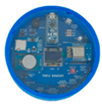 Aquaculture Card |
| Monitoring Water Temperature in “La Cabaña” Fish Farm to Avoid Trout Mortality and Contaminated Consumption | The project monitored fish farm water temperature to prevent trout mortality and human consumption of contaminated meat, using the aquaculture card, temperature sensor, and mBlock. |  DS18B20 Water Temperature Sensor | 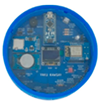 Aquaculture Card |
| Monitoring Children’s Body Temperature to Prevent Fever Outbreaks in Mariscal Cáceres School, Tayacaja | The project monitored children’s body temperature to prevent fever outbreaks using the health card, body temperature sensor, and mBlock programming environment. |  MLX90614 Body Temperature Sensor |  Health Card |
| Engineering | Nursing |
|---|---|
|
|
| Phases of the Problem-Solving Method | Engineering | Nursing | ||||||||||
|---|---|---|---|---|---|---|---|---|---|---|---|---|
| Mean | Median | Standard Deviation | Mean | Median | Standard Deviation | |||||||
| Pre Test | Pos Test | Pre Test | Pos Test | Pre Test | Pos Test | Pre Test | Pos Test | Pre Test | Pre Test | Pos Test | Pre Test | |
| Understanding the problem | 25.0 | 26.6 | 25.0 | 26.0 | 3.57 | 3.62 | 4.31 | 4. 45 | 4.00 | 4.31 | 4. 45 | 4.00 |
| Designing activities | 16.9 | 17.9 | 17.0 | 17.5 | 2.34 | 2.64 | 3.50 | 3.84 | 3.00 | 3.50 | 3.84 | 3.00 |
| Implementing activities | 19.0 | 19.6 | 19.0 | 19.5 | 2.09 | 2.67 | 4.19 | 4.25 | 4.00 | 4.19 | 4.25 | 4.00 |
| Reviewing the solution | 24.7 | 26.9 | 24.5 | 28.0 | 2.95 | 3.61 | 4.05 | 4.30 | 4.00 | 4.05 | 4.30 | 4.00 |
| Engineering | Nursing | |||
|---|---|---|---|---|
| Pre-Test | Post-Test | PRE-TEST | Post-Test | |
| Test | Shapiro–Wilk | Kolmogorov–Smirnov | ||
| N | 34 | 34 | 64 | 64 |
| W/Statistic | 0.983 | 0.991 | 0.361 | 0.218 |
| p-value | 0.864 | 0.993 | <0.001 | <0.002 |
| Problem-Solving Phases | Engineering | Nursing | ||
| H0 = “The implementation of a problem-solving method based on Pólya’s approach and complemented with an Arduino board and sensors does not contribute to strengthening research competences in engineering students”. | H0 = “The implementation of a problem-solving method based on Pólya’s approach and complemented with an electronic STEM educational kit does not contribute to strengthening research competences in nursing students”. | |||
| H1 = “The implementation of a problem-solving method based on Pólya’s approach and complemented with an Arduino board and sensors contributes to strengthening research competencies in engineering students”. | H1 = “The implementation of a problem-solving method based on Pólya’s approach and complemented with an electronic STEM educational kit contributes to strengthening research competences in nursing students”. | |||
| Significance level: 5% Decision: if p ≥ 0.05 → do not reject H0; if p < 0.05 → reject H0 | Significance level: 5% Decision: if p ≥ 0.05 → do not reject H0; if p < 0.05 → reject H0 | |||
| p-Value (Student’s t-Test) | Decision | p-Value (Student’s Wilcoxon) | Decision | |
| Understanding the problem | 0.022 | Reject H0 | 0.001 | Reject H0 |
| Designing activities | 0.021 | Reject H0 | 0.002 | Reject H0 |
| Implementing activities | 0.041 | Reject H0 | 0.002 | Reject H0 |
| Reviewing the solution | 0.001 | Reject H0 | 0.006 | Reject H0 |
Disclaimer/Publisher’s Note: The statements, opinions and data contained in all publications are solely those of the individual author(s) and contributor(s) and not of MDPI and/or the editor(s). MDPI and/or the editor(s) disclaim responsibility for any injury to people or property resulting from any ideas, methods, instructions or products referred to in the content. |
© 2025 by the authors. Licensee MDPI, Basel, Switzerland. This article is an open access article distributed under the terms and conditions of the Creative Commons Attribution (CC BY) license (https://creativecommons.org/licenses/by/4.0/).
Share and Cite
Paucar-Curasma, R.; Unsihuay-Tovar, R.F.; Acra-Despradel, C.; Villalba-Condori, K.O. Integration of Technological Resources and Problem-Solving Method for the Development of Research Competencies in Engineering and Nursing Students from Two Public Universities in Peru. Educ. Sci. 2025, 15, 1250. https://doi.org/10.3390/educsci15091250
Paucar-Curasma R, Unsihuay-Tovar RF, Acra-Despradel C, Villalba-Condori KO. Integration of Technological Resources and Problem-Solving Method for the Development of Research Competencies in Engineering and Nursing Students from Two Public Universities in Peru. Education Sciences. 2025; 15(9):1250. https://doi.org/10.3390/educsci15091250
Chicago/Turabian StylePaucar-Curasma, Ronald, Roberto Florentino Unsihuay-Tovar, Claudia Acra-Despradel, and Klinge Orlando Villalba-Condori. 2025. "Integration of Technological Resources and Problem-Solving Method for the Development of Research Competencies in Engineering and Nursing Students from Two Public Universities in Peru" Education Sciences 15, no. 9: 1250. https://doi.org/10.3390/educsci15091250
APA StylePaucar-Curasma, R., Unsihuay-Tovar, R. F., Acra-Despradel, C., & Villalba-Condori, K. O. (2025). Integration of Technological Resources and Problem-Solving Method for the Development of Research Competencies in Engineering and Nursing Students from Two Public Universities in Peru. Education Sciences, 15(9), 1250. https://doi.org/10.3390/educsci15091250







